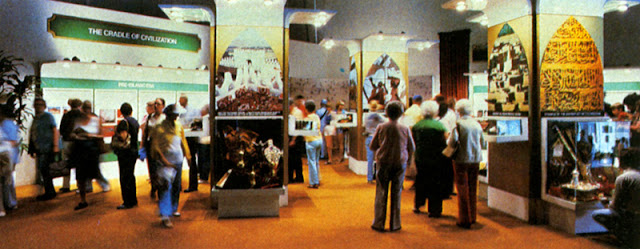 Young Saudis dressed in native garb guide visitors through the pavilion, which is easily recognized by its surrounding arches.
Young Saudis dressed in native garb guide visitors through the pavilion, which is easily recognized by its surrounding arches.Exhibit areas include Islam; Bedouin Tradition and the Cradle of Civilization; Industriel Development; Human Ressources, and 50 Years of U.S.-Saudi Relations.
From the prophet Abraham and his son Ismael, the Arabs and a distinct Arabian civilization can be dated from 3,500 B.C. Ancient Arab cities were important commercial and cultural centers along the trade routes that extended from Rome to Persia, and gave birth to an empire in the 7th century.
Stimulated by the spiritual, moral and intellectual power of Islam and its prophet Muahammad, the arab people spread their civilization, language and religion around the world. Currently, Saudi Arabia's lightning-paced industrial and human development signals its re-emergence in world political and economic affairs.
Here is a closer look at these specific areas of the Saudi Arabian Exhibit.
Islam
The centerpiece of the Saudi Arabian pavilion is a 400 square foot display featuring an animated model of the Grand Mosque of Mecca.
It symbolizes the centrality of Islam in Saudi Arabian life and historical experience.
The Kaaba, a black cube-shapped building around which the mosque is built, is the focal point of the prayers of the world's 800 million Muslims and center for yearly pilgrimage.
Traditional society
A second area of the pavilion focuses on the history of pre-Islamic Arabia, as well as the traditions and values of the Bedouin tribes of the Arabian desert.
The bedouin's life-and-death struggle to survive in a harsh environment is given expression by his philosophical and aesthetic appreciation of life.

This is reflected in various art formes, particularly the medium of poetry.
U.S.-Saudi relations
U.S. technology and experience have figured largely in Saudi development, as highlighted in the final exhibit area, U.S.-Saudi relations.
Cooperation and friendship, based on strong commercial and financial ties, have characterized dealings between the two nation. In a part of the world that is politically and geographically strategic, Saudi Arabia's interests coincide with those of the United States in ensuring political moderation and stability in the region.







No comments:
Post a Comment